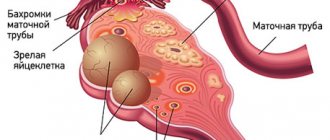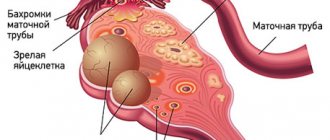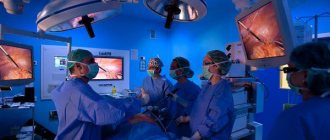Pain after laparoscopy occurs in all patients. This is due to injury to the soft tissues of the anterior abdominal wall, peritoneum and internal organs. Pain syndrome can be caused by carbon dioxide or argon residues that are injected into the abdomen during surgery. After laparoscopy, the stomach pain is not as intense as after a classic operation. Rehabilitation and healing of the wound is much faster. To relieve pain on the first day, narcotic analgesics, lidocaine, and nonsteroidal anti-inflammatory drugs are prescribed. The intensity of pain decreases significantly 12-24 hours after the intervention; minor discomfort may continue for several days.
Immediately after surgery
Recovery after abdominoplasty is a long process due to extensive tissue trauma, and pain is always present in the early postoperative period. To stop it, the doctor may prescribe non-steroidal anti-inflammatory drugs or narcotic drugs. The choice of remedy depends on the intensity of the pain syndrome and the individual sensitivity threshold. Patients, in addition to muscle pain, note a feeling of tightness, which is also relieved by painkillers and goes away after a few weeks. Swelling and hematomas are also present.
Immediately after the end of general anesthesia, nausea and dizziness occur. These sensations go away after a few hours. The SM-Clinic uses the most modern means for general anesthesia, so hallucinations, delusions and other unpleasant symptoms are excluded. Recurrence of dizziness and nausea is possible after taking narcotic painkillers, but if you follow the doctor’s recommendations, the body adapts and copes with the “symptoms”.
In the first few days:
- the patient is in a hospital under round-the-clock supervision of medical personnel;
- the stomach will be hard and painful to the touch;
- There will be a bandage and drains at the incision sites, which are cleaned several times a day;
- you need to stay in bed, get up with the help of medical personnel or relatives.
How does your stomach hurt after laparoscopy?
Laparoscopy gives varying degrees of pain. In the first hours after surgery, their intensity is estimated at 60 points on a 100-point scale. After 6-12 hours their intensity decreases to 30 points, and after a day - to 10 points. In women after gynecological operations, the pain syndrome is slightly more pronounced. If the pain intensity is higher, this may indicate nerve damage and blood flow problems. An increase in pain during the day after its objective reduction may be a signal of infectious complications. Patients often develop a fever at the same time.
After laparoscopy, the stomach hurts on the first day, first at the puncture site, then the pain moves to the upper part, under the diaphragm. On the second day, when visceral pain decreases after laparoscopy, unpleasant sensations appear in the back, shoulder, shoulder blades, and upper abdomen. They are associated with the consequences of pneumoperitoneum (injection of gas into the abdominal cavity during intervention). After laparoscopy the right side hurts more. About 43% of patients complain of pain in the right upper quadrant of the abdomen, 40% of pain in the lower third of the shoulder, and 20% of back pain. Some patients after endotracheal anesthesia may experience a sore throat on the first day, which quickly passes without additional treatment.
On days 5-6 after laparoscopy, the pain practically disappears. Unpleasant sensations or pain may occur with sudden movement or overexertion. Therefore, it is not recommended to lift weights in the first 4 weeks; it is advised to limit physical activity. Increased pain in the long-term postoperative period may indicate infection, ischemia of an organ, or other complications. Such symptoms require immediate medical attention. When pain after laparoscopy appears several months later, this may be a sign of the formation of adhesions.
Early rehabilitation after abdominoplasty
As a rule, abdominoplasty is a standard operation. The patient remains in the hospital for 3-4 days, and after discharge regularly comes to the doctor for examinations and treatment of sutures.
When are stitches removed after abdominoplasty?
If the sutures were applied with non-absorbable threads, they are removed after 5-10 days. However, your doctor may decide to leave the stitches in for two weeks or more. At the same time, some areas may heal faster, others slower, so the stitches can be removed gradually - first in one place, then in another, and so on gradually until everything heals. The removal procedure is completely painless, after which the incision site no longer needs to be processed.
Seam processing
Sutures should be treated twice a day and the bandage should be changed regularly so that the wound heals faster and eliminates the risk of infection. You cannot remove the crusts yourself - they should gradually fall off on their own. If they are damaged, indentations and scars will remain on the skin.
The drainage after abdominoplasty is removed after 2-4 days. If rubber graduates have been introduced, they can be left for 10 days. It all depends on the volume of waste liquid.
Swelling after abdominoplasty
Swelling is a normal phenomenon, the body’s reaction to surgery. In the first days, swelling may increase, and then it will gradually disappear. This may take several weeks. To relieve discomfort and quickly relieve swelling, you can apply a dry cold compress, unless there are contraindications from a doctor. Sometimes the doctor may prescribe other recommendations.
If the patient has diseases of the cardiovascular system, then the swelling will be greater. It is also influenced by the phase of the menstrual cycle, diet, exercise regimen and general activity of the patient. In order for the swelling to go away faster, you need to maintain the water-salt balance recommended by your doctor.
How are adhesions treated?
According to the timing of formation of adhesions, they are distinguished:
- 7-14 days after surgery – the phase of young adhesions, when the adhesions are still very loose and easily torn;
- 14-30 days after surgery is the phase of mature adhesions, when the adhesions thicken and become strong.
Starting from the 30th day after the operation and further, for several years, the process of restructuring and formation of scars and adhesions occurs. The process is individual, much depends on the properties of the organism itself, its anatomical structure, and the functioning of internal organs.
The doctor may suspect the presence of adhesions in the abdominal cavity based on clinical data, medical history, and the results of studies such as ultrasound, CT, and colonoscopy. Adhesions in the abdominal cavity and pelvic cavity can be treated with medication or surgery. During surgery, the adhesions are separated, but this method should be used only in extreme cases, if the cords are so thick and rough that they severely disrupt the function of the organ, and more loyal and gentle treatment does not help.
How long to wear compression garments after abdominoplasty?
Compression garments are special items of underwear that support the operated soft tissues. The products are made from elastic but breathable fabrics, so they are comfortable and free from diaper rash. The essence of compression garments is that, covering a certain area of the body, it creates uniform and constant pressure on it from all sides. This provides abdominal support and improves blood circulation, which speeds healing. Pressure numbers vary between 17-20 mmHg. Art., which is enough to preserve the silhouette modeled by the surgeon. The linen reduces swelling and general discomfort, stabilizes tissue during the healing period. When swelling disappears, the main function of underwear remains to support the abdomen. According to patient reviews, if you do not wear compression garments, persistent pain persists in the first weeks after surgery.
Main advantages of linen:
- effective support;
- beneficial overall effect on the healing process;
- bandages and bandages are hidden underneath, they will not move or get dirty, which means there will be no infection;
- the applied pressure accelerates the scarring process;
- pressure uniformity reduces the risk of hypertrophic and keloid scars;
- One of the recommendations after abdominoplasty is diet, and underwear that puts pressure on the stomach helps control satiety.
For the first 10-14 days, compression garments cannot be removed around the clock. During the first month after abdominoplasty, if it is not possible to wear another set while washing and drying clothes, then you need to be in a horizontal position all this time.
How long to wear a bandage after abdominoplasty?
In the first two weeks - constantly. Then you can remove it while washing or washing/drying the set. In general, how long you will need to wear a corset after abdominoplasty is determined individually. On average it is 1.5-2 months.
Why are adhesions bad?
Nature made sure that in our harmonious body the organs were equipped and arranged clearly and correctly, like in Tetris. They occupy the entire internal space and touch each other with suitable sides, like a carefully fitted puzzle. If you consider all the organs separately from the body, you will be amazed at how much space they take up and how they fit inside us! It is precisely because postoperative scars and adhesions disrupt this initial harmony that they affect our body.
What is the negative impact of adhesions? They:
- interfere with the mobility of the organ, which affects its function. Moreover, both external mobility, which depends on the movements of the diaphragm, suffers, as well as internal mobility, which is active and does not depend on the movement of the diaphragm;
- disrupt blood circulation in the affected organ;
- disrupt the innervation of the organ;
- contribute to the occurrence of pain and spasms in the organ.
Sometimes the adhesion is so powerful that it can disrupt the anatomically correct position of the organ. All of the above reasons lead to other disorders in the body. And yet, which at first glance are not related to the affected area. Adhesions and scars that arise after abdominal surgery can cause pain in various parts of the spine, joints, lead to changes in posture and disruption of the body’s position in space, etc.
Recovery period at home
If the operation was serious, the patient is discharged from the hospital on the fourth day. If the intervention was minor, then on the second. The success of the recovery period and the quality of healing directly depend on compliance with the doctor’s recommendations. Sometimes you have to give up your usual way of life for one year. After about this time, the marks from the seams also completely disappear.
Basic rules for restoring a house:
- Be sure to wear compression garments in the manner recommended by the doctor. Usually for another 2-3 months after constant wearing, it is worn during periods of high physical activity.
- In the first few weeks, you need to walk, sit and sleep slightly bent so that there is no tension on the stitches. This way the tissues will grow together better.
- It is best to sleep on your back with your knees bent. Most of your time should be spent resting.
- In the first three months, any physical activity is prohibited, including lifting objects heavier than three kilograms, fitness, and athletics. Exercises can be done only those prescribed by the doctor.
- If the work does not involve physical activity, the sick leave can be closed within a week. Otherwise – in a month.
- Before removing the stitches, you can shower, but do not get them wet.
- For two months you should not overheat - go to the bathhouse, sauna, or take a hot bath.
- In the first six months, the abdominal area should not be exposed to ultraviolet radiation, so you should not sunbathe on beaches or in a solarium.
- In the postoperative period, diet is important. You need to eat five to six times a day in small portions. In the first week, you need to exclude foods that cause flatulence: cabbage, bananas, legumes, fresh vegetables and fruits, baked goods, carbonated drinks.
- Until the stitches are removed, you need to avoid intimacy, and after that, be careful and avoid pain in the abdominal area.
- Taking any medications should be agreed with your doctor, even the simplest painkillers.
Why does pain occur after laparoscopy?
Therapeutic and diagnostic laparoscopy causes pain for several reasons. The first is associated with damage to soft tissues and internal organs, irritation of the peritoneum. The pain is concentrated in the area of the postoperative wound, in the parts of the abdomen where surgery was performed. The next cause of pain after laparoscopy is too much stretching of the peritoneum due to the introduction of 3-4 liters of carbon dioxide into the abdominal cavity. Unpleasant sensations occur in the upper abdomen, back and shoulders.
The pathogenesis of pain after laparoscopy associated with pneumoperitoneum is not fully understood. Some researchers believe that it is caused by irritation of the peritoneum with carbon dioxide. This theory is confirmed by the fact that laparoscopy produces less pain if nitric oxide or argon is used instead of CO2. Other researchers argue that the pain syndrome is associated exclusively with mechanical stretching of the peritoneum and the presence of a gas bubble under the diaphragm. It is most likely that both factors are important.
Also, the reason that the stomach hurts after laparoscopy can be irritation of the nerves of the diaphragm and abdominal cavity, damage to blood vessels and impaired blood flow. The main mechanism of pain is the release of inflammatory mediators (prostaglandins, cyclooxygenase, etc.). An inflammatory process of varying intensity occurs after any injury (including surgery). It intensifies with infectious complications. In such a situation, after laparoscopy, the stomach hurts more intensely, the patient’s temperature rises, purulent discharge from the wound appears, and tension in the anterior abdominal wall appears.
If complications arise
In some cases, the gas introduced during surgery is not removed from the body on its own. One of the common problems is subcutaneous emphysema - the accumulation of air in the subcutaneous tissue. If emphysema appears in the face and neck area and reaches a large size, the surgeon will decide on repeated intervention or installation of a special drainage. In other cases, active medical action is not required.
Medicine to eliminate bloating
If there is severe bloating after surgery, accompanied by digestive problems, medication may be required. Most often, positive dynamics are observed when taking Espumisan, Simethicotin; in some cases, a sufficient effect is observed from standard activated carbon. A number of doctors prefer to prescribe Polysorb.










